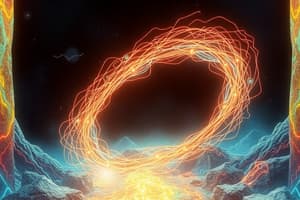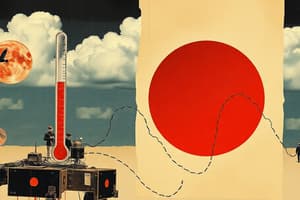Podcast
Questions and Answers
Which of the following is an accurate statement about the relationship between heat, work, and thermal energy?
Which of the following is an accurate statement about the relationship between heat, work, and thermal energy?
- Heat, work, and thermal energy are all state functions.
- Heat and work are path functions, while thermal energy is a state function. (correct)
- Heat and work are state functions, while thermal energy is a path function.
- Heat and thermal energy are path functions, while work is a state function.
What distinguishes a reversible process from an irreversible process?
What distinguishes a reversible process from an irreversible process?
- A reversible process can be returned to its initial state without any net change in the system or its surroundings, while an irreversible process cannot. (correct)
- A reversible process involves a large, rapid change in the system, while an irreversible process occurs slowly and gradually.
- A reversible process occurs spontaneously, while an irreversible process requires external intervention.
- A reversible process dissipates energy as heat, while an irreversible process conserves energy.
How is the specific heat capacity used to determine the heat required to change the temperature of an object?
How is the specific heat capacity used to determine the heat required to change the temperature of an object?
- By dividing the specific heat capacity by the change in temperature and multiplying by the object's mass.
- By adding the specific heat capacity to the object's mass and multiplying by the change in temperature.
- By multiplying the specific heat capacity by the change in temperature and dividing by the object's mass.
- By multiplying the specific heat capacity by the object's mass and the change in temperature. (correct)
What is the key difference between microstates and macrostates?
What is the key difference between microstates and macrostates?
Which of the following scenarios correctly applies the fundamental assumption in calculating the probability of a macrostate in thermal equilibrium?
Which of the following scenarios correctly applies the fundamental assumption in calculating the probability of a macrostate in thermal equilibrium?
How does the Boltzmann formula relate entropy to multiplicity?
How does the Boltzmann formula relate entropy to multiplicity?
Under what conditions does the formula $1/T = \frac{\partial S}{\partial U}$ accurately describe the relationship between temperature, entropy, and internal energy?
Under what conditions does the formula $1/T = \frac{\partial S}{\partial U}$ accurately describe the relationship between temperature, entropy, and internal energy?
What is the primary use of the Boltzmann factor?
What is the primary use of the Boltzmann factor?
What does the Equipartition Theorem allow us to calculate?
What does the Equipartition Theorem allow us to calculate?
How does the ideal gas law relate pressure, volume, and temperature?
How does the ideal gas law relate pressure, volume, and temperature?
What is the thermal energy, U, of an ideal gas?
What is the thermal energy, U, of an ideal gas?
What is the value of d for a monatomic gas?
What is the value of d for a monatomic gas?
What does the Maxwell-Boltzmann distribution primarily describe?
What does the Maxwell-Boltzmann distribution primarily describe?
What is the 'most probable speed' in the Maxwell-Boltzmann distribution?
What is the 'most probable speed' in the Maxwell-Boltzmann distribution?
Which statement best describes a quasistatic process?
Which statement best describes a quasistatic process?
What are the constrained processes listed by the text?
What are the constrained processes listed by the text?
Within a PV diagram, how is the work done by a process calculated?
Within a PV diagram, how is the work done by a process calculated?
What is the calculation for entropy change in a quasistatic process?
What is the calculation for entropy change in a quasistatic process?
What is the purpose of a 'replacement process' when evaluating changes in functions of state?
What is the purpose of a 'replacement process' when evaluating changes in functions of state?
What is a 'cyclic process'?
What is a 'cyclic process'?
What is the definition of a heat engine?
What is the definition of a heat engine?
What determines the maximum possible efficiency of a heat engine?
What determines the maximum possible efficiency of a heat engine?
What equation describes the optimal maximum efficiency?
What equation describes the optimal maximum efficiency?
Which of the following statements accurately describes the coefficient of performance (COP) of a refrigerator?
Which of the following statements accurately describes the coefficient of performance (COP) of a refrigerator?
Which formula is useful for the performance limitations of a refrigerator?
Which formula is useful for the performance limitations of a refrigerator?
What is the relationship between pressure and force in a hydraulic system, according to Pascal's principle?
What is the relationship between pressure and force in a hydraulic system, according to Pascal's principle?
According to Archimedes's principle, what determines whether an object will sink or float in a fluid?
According to Archimedes's principle, what determines whether an object will sink or float in a fluid?
A closed system undergoes a process where its entropy decreases. What can be correctly inferred about this process?
A closed system undergoes a process where its entropy decreases. What can be correctly inferred about this process?
A container holds a mixture of Helium and Oxygen molecules in thermal equilibrium. If Oxygen molecules are more massive, what can be said about the average thermal energy of each gas?
A container holds a mixture of Helium and Oxygen molecules in thermal equilibrium. If Oxygen molecules are more massive, what can be said about the average thermal energy of each gas?
What happens to thermal energy during an isothermal expansion of an ideal gas?
What happens to thermal energy during an isothermal expansion of an ideal gas?
There is an ice cube in a water filled cup. What happens when you leave it out?
There is an ice cube in a water filled cup. What happens when you leave it out?
A system contains four energy units distributed among three distinguishable particles. How many distinct microstates are possible?
A system contains four energy units distributed among three distinguishable particles. How many distinct microstates are possible?
Consider a large Einstein solid in the low-temperature limit, described by the multiplicity function Ω = (eN/q)^q. If N is the number of oscillators and q represents units of energy, how does the entropy (S) of this solid relate to these parameters, according to the Boltzmann formula?
Consider a large Einstein solid in the low-temperature limit, described by the multiplicity function Ω = (eN/q)^q. If N is the number of oscillators and q represents units of energy, how does the entropy (S) of this solid relate to these parameters, according to the Boltzmann formula?
In an adiabatic process involving a monatomic ideal gas, the temperature increases from 35°C to 45°C. Given that the gas contains 4.2 × 10^23 molecules, calculate the change in thermal energy of the gas. (kB = 1.381 × 10^-23 J/K)
In an adiabatic process involving a monatomic ideal gas, the temperature increases from 35°C to 45°C. Given that the gas contains 4.2 × 10^23 molecules, calculate the change in thermal energy of the gas. (kB = 1.381 × 10^-23 J/K)
For an ideal Carnot engine operating between two reservoirs at temperatures of 250°C and 10°C, what is the engine’s efficiency?
For an ideal Carnot engine operating between two reservoirs at temperatures of 250°C and 10°C, what is the engine’s efficiency?
Two water reservoirs are connected via a manometer containing mercury. If the difference in the manometer reading is 25.0 cm and the densities of water and mercury are 1000 kg/m³ and 13,600 kg/m³, respectively, what is the difference in elevation $h$ between the water levels in the reservoirs?
Two water reservoirs are connected via a manometer containing mercury. If the difference in the manometer reading is 25.0 cm and the densities of water and mercury are 1000 kg/m³ and 13,600 kg/m³, respectively, what is the difference in elevation $h$ between the water levels in the reservoirs?
If a 100 kg object with a volume of 1 m³ is submerged 2 meters below the surface of water, determine the net force on the object specifying the direction.
If a 100 kg object with a volume of 1 m³ is submerged 2 meters below the surface of water, determine the net force on the object specifying the direction.
In the context of thermodynamics, what is the relationship between heat, work, and thermal energy as described by the first law?
In the context of thermodynamics, what is the relationship between heat, work, and thermal energy as described by the first law?
What is the fundamental assumption used to calculate the probability of a macrostate in thermal equilibrium?
What is the fundamental assumption used to calculate the probability of a macrostate in thermal equilibrium?
How does the multiplicity of a macrostate relate to its probability of occurring in a system at thermal equilibrium?
How does the multiplicity of a macrostate relate to its probability of occurring in a system at thermal equilibrium?
What is the significance of the constant kB in the Boltzmann formula, $S = k_B \ln \Omega$?
What is the significance of the constant kB in the Boltzmann formula, $S = k_B \ln \Omega$?
What does it imply if the temperature, T, is defined as $1/T = ∂S/∂U$ for constant V and N?
What does it imply if the temperature, T, is defined as $1/T = ∂S/∂U$ for constant V and N?
How would you apply the equipartition theorem to calculate energy distribution?
How would you apply the equipartition theorem to calculate energy distribution?
For an ideal gas, under what condition is the relationship between pressure, volume, and temperature accurately described by the ideal gas law, $PV = Nk_BT$?
For an ideal gas, under what condition is the relationship between pressure, volume, and temperature accurately described by the ideal gas law, $PV = Nk_BT$?
What is the significance of the variable d when calculating the thermal energy $U = (d/2)Nk_BT$ for an ideal gas?
What is the significance of the variable d when calculating the thermal energy $U = (d/2)Nk_BT$ for an ideal gas?
What key property does the Maxwell-Boltzmann distribution describe for a gas at a certain temperature?
What key property does the Maxwell-Boltzmann distribution describe for a gas at a certain temperature?
What characterizes the 'most probable speed' in the Maxwell-Boltzmann distribution?
What characterizes the 'most probable speed' in the Maxwell-Boltzmann distribution?
What is a key characteristic of constrained processes (isobaric, isochoric, isothermal, adiabatic)?
What is a key characteristic of constrained processes (isobaric, isochoric, isothermal, adiabatic)?
How can the work done by a process be determined from a PV diagram?
How can the work done by a process be determined from a PV diagram?
How is entropy change calculated in a quasistatic process?
How is entropy change calculated in a quasistatic process?
What is a 'replacement process' primarily used for in thermodynamics?
What is a 'replacement process' primarily used for in thermodynamics?
What condition defines a 'cyclic process' in thermodynamics?
What condition defines a 'cyclic process' in thermodynamics?
What is the primary function of a heat engine?
What is the primary function of a heat engine?
What primarily dictates the maximum possible efficiency of a heat engine?
What primarily dictates the maximum possible efficiency of a heat engine?
How do you describe the coefficient of performance (COP) for a refrigerator?
How do you describe the coefficient of performance (COP) for a refrigerator?
How does pressure relate to forces in a hydraulic system, according to Pascal's principle?
How does pressure relate to forces in a hydraulic system, according to Pascal's principle?
What factors determine whether an object floats or sinks in a fluid, according to Archimedes' principle?
What factors determine whether an object floats or sinks in a fluid, according to Archimedes' principle?
If two systems, A and B, are in thermal equilibrium, what statement is true regarding their ability to spontaneously exchange energy?
If two systems, A and B, are in thermal equilibrium, what statement is true regarding their ability to spontaneously exchange energy?
What is the relationship between multiplicity and entropy?
What is the relationship between multiplicity and entropy?
For an Einstein solid, how does the number of oscillators (N) and energy units (q) affect the multiplicity?
For an Einstein solid, how does the number of oscillators (N) and energy units (q) affect the multiplicity?
How does the second law of thermodynamics apply to the entropy of the universe?
How does the second law of thermodynamics apply to the entropy of the universe?
How can one determine probability from the boltzmann factor?
How can one determine probability from the boltzmann factor?
To derive heat capacity from statistical mechanics, what are the major assumptions used to be able to use Stirling's approximation?
To derive heat capacity from statistical mechanics, what are the major assumptions used to be able to use Stirling's approximation?
What does the Einstein temperature describe?
What does the Einstein temperature describe?
Which of the following is the correct definition of temperature?
Which of the following is the correct definition of temperature?
Which of the following is the multiplicity of an Einstein Solid?
Which of the following is the multiplicity of an Einstein Solid?
What is the difference between the canonical and mircrocanonical ensemble?
What is the difference between the canonical and mircrocanonical ensemble?
What makes entropy extensive?
What makes entropy extensive?
What is the primary aim in analyzing the Microcanonical ensemble?
What is the primary aim in analyzing the Microcanonical ensemble?
If two systems with different internal energies, $U_A$ and $U_B$, are brought into thermal contact, how is the total entropy maximized?
If two systems with different internal energies, $U_A$ and $U_B$, are brought into thermal contact, how is the total entropy maximized?
Under what conditions is energy transfer between two systems in thermal contact considered to be most efficient?
Under what conditions is energy transfer between two systems in thermal contact considered to be most efficient?
How does the concept of entropy relate to the second law of thermodynamics in an isolated system?
How does the concept of entropy relate to the second law of thermodynamics in an isolated system?
What is the relationship between the total pressure, atmospheric pressure, and gauge pressure?
What is the relationship between the total pressure, atmospheric pressure, and gauge pressure?
How does the energy distribution of gas molecules change with increasing temperature according to the Maxwell-Boltzmann distribution?
How does the energy distribution of gas molecules change with increasing temperature according to the Maxwell-Boltzmann distribution?
Suppose a system's multiplicity sharply peaks at a particular macrostate. What does this imply about the system's behavior over time?
Suppose a system's multiplicity sharply peaks at a particular macrostate. What does this imply about the system's behavior over time?
Why is entropy considered an extensive property?
Why is entropy considered an extensive property?
According to the second law of thermodynamics, what is the most accurate way to describe the entropy of an isolated system?
According to the second law of thermodynamics, what is the most accurate way to describe the entropy of an isolated system?
Why is the function $f(T) = 1/T$ chosen for relating temperature to the change in entropy with respect to internal energy?
Why is the function $f(T) = 1/T$ chosen for relating temperature to the change in entropy with respect to internal energy?
In the context of statistical mechanics, what is the significance of the 'thermal reservoir'?
In the context of statistical mechanics, what is the significance of the 'thermal reservoir'?
What is the main purpose of the partition function in statistical mechanics?
What is the main purpose of the partition function in statistical mechanics?
How does increasing the temperature of a system affect the distribution of particles across available energy states, according to the Boltzmann factor?
How does increasing the temperature of a system affect the distribution of particles across available energy states, according to the Boltzmann factor?
Consider a quantum system with discrete energy levels. What does calculating the expected energy using the partition function tell us about the system at a given temperature?
Consider a quantum system with discrete energy levels. What does calculating the expected energy using the partition function tell us about the system at a given temperature?
An Einstein solid is used to model a crystal. Which statement correctly relates the behavior of the Einstein solid at high temperatures to its heat capacity?
An Einstein solid is used to model a crystal. Which statement correctly relates the behavior of the Einstein solid at high temperatures to its heat capacity?
What is the physical interpretation of the Einstein temperature in the context of an Einstein solid?
What is the physical interpretation of the Einstein temperature in the context of an Einstein solid?
How can one determine the multiplicity if they increase the internal energy of a isolated system?
How can one determine the multiplicity if they increase the internal energy of a isolated system?
Why is temperature typically kept constant when wanting to determine the change in entropy?
Why is temperature typically kept constant when wanting to determine the change in entropy?
To derive heat capacity from statistical mechanics using Einstein's model, which of the following assumptions is invoked?
To derive heat capacity from statistical mechanics using Einstein's model, which of the following assumptions is invoked?
When comparing the microcanonical ensemble to the canonical ensemble which statement is true?
When comparing the microcanonical ensemble to the canonical ensemble which statement is true?
Using the Einstein temperature, which is true about the atomic vibrations?
Using the Einstein temperature, which is true about the atomic vibrations?
Flashcards
Relate Heat, Work, and Thermal Energy
Relate Heat, Work, and Thermal Energy
Heat, Work, and Thermal Energy relate via the 1st law of thermodynamics.
Reversible Process
Reversible Process
A process that can be reversed without any net change to system or surroundings.
Temperature
Temperature
Measure of average kinetic energy of particles in a system.
Specific Heat Capacity
Specific Heat Capacity
Signup and view all the flashcards
Microstate
Microstate
Signup and view all the flashcards
Macrostate
Macrostate
Signup and view all the flashcards
Multiplicity
Multiplicity
Signup and view all the flashcards
Fundamental Assumption
Fundamental Assumption
Signup and view all the flashcards
Boltzmann Formula
Boltzmann Formula
Signup and view all the flashcards
Temperature Definition
Temperature Definition
Signup and view all the flashcards
Boltzmann Factor
Boltzmann Factor
Signup and view all the flashcards
Equipartition Theorem
Equipartition Theorem
Signup and view all the flashcards
Ideal Gas Law
Ideal Gas Law
Signup and view all the flashcards
Internal Energy of Ideal Gas
Internal Energy of Ideal Gas
Signup and view all the flashcards
Maxwell-Boltzmann Distribution
Maxwell-Boltzmann Distribution
Signup and view all the flashcards
Quasistatic Process
Quasistatic Process
Signup and view all the flashcards
Isobaric Process
Isobaric Process
Signup and view all the flashcards
Isochoric Process
Isochoric Process
Signup and view all the flashcards
Isothermal Process
Isothermal Process
Signup and view all the flashcards
Adiabatic Process
Adiabatic Process
Signup and view all the flashcards
Entropy Change
Entropy Change
Signup and view all the flashcards
Replacement Process
Replacement Process
Signup and view all the flashcards
Cyclic Process
Cyclic Process
Signup and view all the flashcards
Heat Engine
Heat Engine
Signup and view all the flashcards
Second Law of Thermodynamics
Second Law of Thermodynamics
Signup and view all the flashcards
Heat Engine Efficiency
Heat Engine Efficiency
Signup and view all the flashcards
Optimal Efficiency
Optimal Efficiency
Signup and view all the flashcards
Coefficient of Performance (COP)
Coefficient of Performance (COP)
Signup and view all the flashcards
COP formula
COP formula
Signup and view all the flashcards
Optimal COP
Optimal COP
Signup and view all the flashcards
Pressure
Pressure
Signup and view all the flashcards
Density
Density
Signup and view all the flashcards
Pressure Variation with Depth
Pressure Variation with Depth
Signup and view all the flashcards
Absolute vs Gauge Pressure
Absolute vs Gauge Pressure
Signup and view all the flashcards
Manometers and Barometers
Manometers and Barometers
Signup and view all the flashcards
Pascal's Principle
Pascal's Principle
Signup and view all the flashcards
Archimedes's principle
Archimedes's principle
Signup and view all the flashcards
Object Sinking/Floating
Object Sinking/Floating
Signup and view all the flashcards
Einstein Solid Model
Einstein Solid Model
Signup and view all the flashcards
Microstate
Microstate
Signup and view all the flashcards
Macrostate
Macrostate
Signup and view all the flashcards
Multiplicity
Multiplicity
Signup and view all the flashcards
Macropartition
Macropartition
Signup and view all the flashcards
Fundamental Assumption
Fundamental Assumption
Signup and view all the flashcards
Irreversibility
Irreversibility
Signup and view all the flashcards
Entropy S(M)
Entropy S(M)
Signup and view all the flashcards
Intensive quantities
Intensive quantities
Signup and view all the flashcards
Extensive Quantities
Extensive Quantities
Signup and view all the flashcards
Entropy additivity
Entropy additivity
Signup and view all the flashcards
2nd Law thermodynamics
2nd Law thermodynamics
Signup and view all the flashcards
Temperature equilibrium
Temperature equilibrium
Signup and view all the flashcards
Study Notes
- Study guide for PHYS102 created by M. Leifer on March 24, 2025
Chapter T1: Temperature
- Heat, Work, and Thermal (Internal) Energy are related in the first law of thermodynamics
- A reversible process is different from an irreversible process
- Applies the concept of temperature
- Specific heat capacity calculates the amount of heat needed to change the temperature of an object
Chapter T2: Microstates and Macrostates
- Microstates and macrostates differences
- Calculation of a macrostate's multiplicity in examples
- The fundamental assumption calculates a macrostate's probability for a system in thermal equilibrium
Chapter T3: Entropy and Temperature
- Boltzmann formula S = kB ln Ω can calculate entropy from multiplicity
- Temperature definition 1/T = (dS/dU) can calculate the relationship between T, S, and U with constant volume V and number of particles N
- Otherwise, 1/T = (dS/dU)
Chapter T4: The Boltzmann Factor
- The Boltzmann factor calculates probabilities for energies in thermal equilibrium
- Understands the range of applicability of the Equipartition Theorem calculates how energy is distributed in thermal equilibrium
Chapter T5: The Ideal Gas
- The ideal gas law PV = NkBT (or PV = nRT) calculates the relationship between pressure volume and temperature
- Formula U = (d/2)NkBT, calculates thermal energy
- d = 3 for a monatomic gas, and how d varies with temperature for a diatomic gas
Chapter T6: Molecular Motion in Gases
- Maxwell-Boltzmann distribution qualitatively reasons about the distribution of speeds in an ideal gas
- Maxwell-Boltzmann distribution calculates the different notions of "average" speed (r.m.s, most probable speed, mean)
Chapter T8: Gas Processes
- Concept of a quasistatic process represented on a PV diagram
- Definitions of constrained processes: isobaric, isochoric, isothermal and adiabatic, and what they look like on a PV diagram
- Calculation of the work done by a process under the curve on a PV diagram using the formulas PV = NkBT and U = (d/2)NkBT
Chapter T9: Calculating Entropy Changes
- Formula ∆S = ∫dQ/T calculates the entropy change in a quasistatic process
- Concept of a "replacement process" finds a quasistatic process to calculate changes in functions of state
Chapter T10: Heat Engines
- Concept of a cyclic process state functions return to their original values at the start of each cycle, so ∆U = 0 for a complete cycle
- Definition of a heat engine
- The second law of thermodynamics limits a heat engine's efficiency
- Calculation efficiency using η = |W|/|QH| and the optimal efficiency η = 1-Tc/TH
- The second law of thermodynamics limits the efficiency of a refrigerator
- Calculates performance coefficient using COP = |QC|/|W| and the optimal coefficient COP = Tc/(TH-TC)
Fluids
- Definitions of pressure and density
- ∆P = ρgh calculates pressure variation with depth in an incompressible fluid
- The difference between absolute and gauge pressure P = Patm + Pg
- Patm is atmospheric temperature
- How manometers and barometers work related to pressure differences on the devices
- Pascal's principle shows how pressure and forces are transmitted in a hydraulic system
- Archimedes's principle calculates buoyant forces and understands when an object sinks or floats
Studying That Suits You
Use AI to generate personalized quizzes and flashcards to suit your learning preferences.




